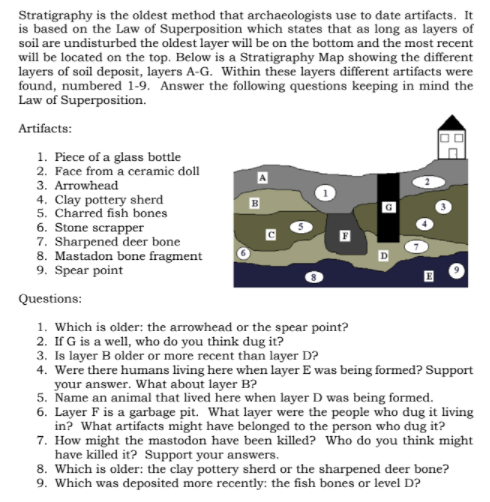Stratigraphy is the oldest method that archaeologists use to date artifacts. It is based on the Law of Superposition which states that as long as layers of soil are undisturbed the oldest layer will be on the bottom and the most recent will be located on the top. Below is a Stratigraphy Map showing the different layers of soil deposit, layers A-G. Within these layers different artifacts were found, numbered 1-9. Answer the following questions keeping in mind the Law of Superposition. Artifacts: 1. Piece of a glass bottle 2. Face from a ceramic doll 3. Arrowhead 4. Clay pottery sherd 5. Charred fish bones 6. Stone scrapper 7. Sharpened deer bone 8. Mastadon bone fragment 9. Spear point Questions: 1. Which is older: the arrowhead or the spear point? 2. If G is a well, who do you think đug it? 3. Is layer B older or more recent than layer D? 4. Were there humans living here when layer E was being formed? Support your answer. What about layer B? 5. Name an animal that lived here when layer D was being formed. 6. Layer F is a garbage pit. What layer were the people who dug it living in? What artifacts might have belonged to the person who dug it? 7. How might the mastodon have been killed? Who do you think might have killed it? Support your answers. 8. Which is older: the clay pottery sherd or the sharpened deer bone? 9. Which was deposited more recently: the fish bones or level D?
Stratigraphy is the oldest method that archaeologists use to date artifacts. It is based on the Law of Superposition which states that as long as layers of soil are undisturbed the oldest layer will be on the bottom and the most recent will be located on the top. Below is a Stratigraphy Map showing the different layers of soil deposit, layers A-G. Within these layers different artifacts were found, numbered 1-9. Answer the following questions keeping in mind the Law of Superposition. Artifacts: 1. Piece of a glass bottle 2. Face from a ceramic doll 3. Arrowhead 4. Clay pottery sherd 5. Charred fish bones 6. Stone scrapper 7. Sharpened deer bone 8. Mastadon bone fragment 9. Spear point Questions: 1. Which is older: the arrowhead or the spear point? 2. If G is a well, who do you think đug it? 3. Is layer B older or more recent than layer D? 4. Were there humans living here when layer E was being formed? Support your answer. What about layer B? 5. Name an animal that lived here when layer D was being formed. 6. Layer F is a garbage pit. What layer were the people who dug it living in? What artifacts might have belonged to the person who dug it? 7. How might the mastodon have been killed? Who do you think might have killed it? Support your answers. 8. Which is older: the clay pottery sherd or the sharpened deer bone? 9. Which was deposited more recently: the fish bones or level D?
Biology 2e
2nd Edition
ISBN:9781947172517
Author:Matthew Douglas, Jung Choi, Mary Ann Clark
Publisher:Matthew Douglas, Jung Choi, Mary Ann Clark
Chapter31: Soil And Plant Nutrition
Section: Chapter Questions
Problem 10RQ: A soil consists of layers called that taken together are called a ________. soil profiles : horizon...
Related questions
Question
please do answer number 8. thank you.

Transcribed Image Text:Stratigraphy is the oldest method that archaeologists use to date artifacts. It
is based on the Law of Superposition which states that as long as layers of
soil are undisturbed the oldest layer will be on the bottom and the most recent
will be located on the top. Below is a Stratigraphy Map showing the different
layers of soil deposit, layers A-G. Within these layers different artifacts were
found, numbered 1-9. Answer the following questions keeping in mind the
Law of Superposition.
Artifacts:
1. Piece of a glass bottle
2. Face from a ceramic doll
3. Arrowhead
4. Clay pottery sherd
5. Charred fish bones
6. Stone scrapper
7. Sharpened deer bone
8. Mastadon bone fragment
9. Spear point
Questions:
1. Which is older: the arrowhead or the spear point?
2. If G is a well, who do you think dug it?
3. Is layer B older or more recent than layer D?
4. Were there humans living here when layer E was being formed? Support
your answer. What about layer B?
5. Name an animal that lived here when layer D was being formed.
6. Layer F is a garbage pit. What layer were the people who dug it living
in? What artifacts might have belonged to the person who dug it?
7. How might the mastodon have been killed? Who do you think might
have killed it? Support your answers.
8. Which is older: the clay pottery sherd or the sharpened deer bone?
9. Which was deposited more recently: the fish bones or level D?
Expert Solution
This question has been solved!
Explore an expertly crafted, step-by-step solution for a thorough understanding of key concepts.
This is a popular solution!
Trending now
This is a popular solution!
Step by step
Solved in 2 steps

Knowledge Booster
Learn more about
Need a deep-dive on the concept behind this application? Look no further. Learn more about this topic, biology and related others by exploring similar questions and additional content below.Recommended textbooks for you

Biology 2e
Biology
ISBN:
9781947172517
Author:
Matthew Douglas, Jung Choi, Mary Ann Clark
Publisher:
OpenStax

Biology 2e
Biology
ISBN:
9781947172517
Author:
Matthew Douglas, Jung Choi, Mary Ann Clark
Publisher:
OpenStax